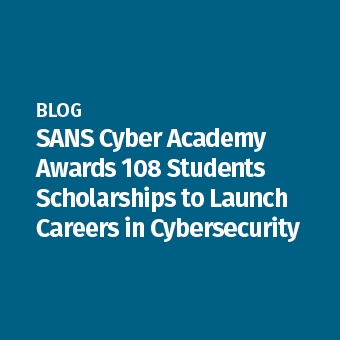Tags:
Zero Trust Network Access (ZTNA) has emerged from the rapidly evolving world of cybersecurity as a critical strategy for protecting networks. In a recent webinar, Chris McCormack, Director of Product Marketing at Sophos, provided valuable insights into best practices for securing networks with ZTNA. Hosted by SANS Certified Instructor Matt Bromiley, the session covered how ZTNA can address modern cyber threats and why it is superior to traditional VPNs.
What is Zero Trust Network Access?
ZTNA is a security framework that fundamentally changes how organizations manage access to their networks. Unlike traditional security models that implicitly trust users once they are inside the network perimeter, ZTNA operates on the principle of “never trust, always verify.” This means that every access request, whether coming from inside or outside the network must be authenticated and authorized before access is granted.
Understanding Modern Cyber Attacks
Chris McCormack began by explaining how modern cyber-attacks typically exploit unknown vulnerabilities and compromised credentials. These attacks often target old VPN clients, remote desktop systems, and unpatched software. “Old VPN clients or servers that are managing incoming VPN connections are becoming priority targets,” he noted, highlighting the increased risk due to the widespread adoption of remote work.
Attackers also use compromised credentials to gain unauthorized access to networks. “Brute force hacking attempts are successful in penetrating systems with poor passwords and the complete lack of multi-factor authentication (MFA),” Chris explained. Once inside, attackers move laterally within the network, using legitimate tools like PowerShell to avoid detection.
Strategies to Mitigate Cyber Threats
To combat these threats, Chris outlined several strategies:
- Reducing the Attack Surface: This involves keeping systems patched and minimizing the number of exposed systems. Ensuring robust patch management is crucial in preventing attackers from exploiting known vulnerabilities.
- Implementing Multi-Factor Authentication (MFA): MFA is essential for protecting against credential abuse. “You need strong passwords, and you need good next-gen endpoint technology as a backup defense,” Chris emphasized.
- Network Segmentation: Segmenting the network both physically and virtually makes it difficult for attackers to move around undetected. “Ensure there’s both software virtual and physical network segmentation of assets in your network,” he advised.
- Active Threat Hunting Tools: Traditional AV detection techniques often fail to spot legitimate tools used maliciously. Active threat hunting tools like XDR (Extended Detection and Response) and NDR (Network Detection and Response) are essential for identifying suspicious behaviors.
The Role of ZTNA in Enhancing Security
ZTNA has become a critical layer of protection against modern attacks, offering a superior alternative to traditional VPNs. Chris explained that ZTNA connects users only to specific applications or systems rather than providing broad network access. “ZTNA only connects a user to a very specific application or system, not the whole network,” he clarified.
Unlike VPNs, ZTNA assesses the health of the end user’s device before granting access. This ensures that compromised devices cannot connect to corporate networks, thereby reducing the risk of lateral movement by attackers. “ZTNA provides much better security than remote access VPN,” Chris asserted, pointing out that it removes vulnerable infrastructure and incorporates device health checks.
Best Practices for Implementing ZTNA
Chris outlined best practices for implementing ZTNA:
- Replace Legacy VPN Infrastructure: ZTNA should replace old remote access VPNs to eliminate vulnerabilities in clients and servers. “ZTNA uses a simpler, lighter agent concept that is more secure,” he noted.
- Integrate ZTNA with Endpoint Security: Ensure that your ZTNA solution is fully integrated with endpoint AV to prevent compromised devices from connecting.
- Use Strong Firewall and Email Security Solutions: Protect against phishing and malicious payloads that can exploit unknown vulnerabilities.
- Stay on Top of User Credential Management: Implement MFA and manage user credentials diligently to prevent abuse.
- Leverage Network Segmentation: Use firewalls, switches, and wireless access points to segment the network and prevent lateral movement.
- Deploy Advanced Threat Detection Tools: Utilize XDR and NDR tools to detect and respond to suspicious activities that traditional security measures might miss.
Sophos Solutions for Network Security
Chris highlighted how Sophos can help organizations implement these best practices. Sophos offers a comprehensive and integrated cybersecurity platform managed from a single cloud console, Sophos Central. This platform includes ZTNA for secure application access, network firewalls, wireless access points, and endpoint security products that work together seamlessly.
“Our network security platform includes ZTNA for secure application access,” Chris said, emphasizing the integration of ZTNA gateway functionality into Sophos firewalls. This eliminates the need for additional on-premises deployments and ensures secure access to apps and systems.
Sophos also offers managed detection and response (MDR) services, providing 24/7 monitoring and expert response to cyber-attacks. “If you don’t want to build a SOC team that does threat hunting, we offer this managed detection and response service,” Chris explained, making it clear that Sophos aims to simplify cybersecurity management for organizations.
Chris McCormack’s presentation underscored the importance of adopting ZTNA as a critical component of network security. By replacing traditional VPNs with ZTNA, organizations can significantly enhance their security posture, prevent unauthorized access, and protect against sophisticated cyber threats. With comprehensive solutions like those offered by Sophos, organizations can implement best practices, integrate security measures, and leverage advanced threat detection tools to safeguard their networks in today’s complex cybersecurity landscape.
IMPLEMENTING A ZERO TRUST ARCHITECTURE is not a one-size-fits-all solution; it requires careful planning, implementation, and ongoing management. For those interested in delving deeper into the subject, SANS has recently released a Zero Trust strategy guide. This document is an excellent resource for anyone looking to learn more about the principles, implementation strategies, and benefits of adopting a Zero Trust Architecture in their organization.





